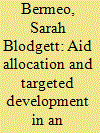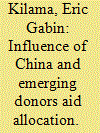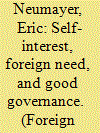| Srl | Item |
| 1 |
ID:
156711


|
|
|
|
|
| Summary/Abstract |
Aid donors pursue a strategy of targeted development with regard to recipient states. The determinants of aid allocation have shifted significantly. Industrialized states are increasingly unable to insulate themselves from spillovers caused by underdevelopment abroad. Donors attempt to use aid to decrease these spillovers, targeting developing countries where the effects on the donor are anticipated to be large. Once a recipient is chosen, concern for recipient government capacity guides the composition of aid. Empirical analysis of aid allocation from 1973 to 2012 demonstrates that, while explanations based on security and economic ties to the donor explain allocation well in the Cold War, the post-2001 period is best understood by incorporating a role for targeted development. This framework helps synthesize various findings in the aid allocation literature and has important implications for studying aid effectiveness.
|
|
|
|
|
|
|
|
|
|
|
|
|
|
|
|
| 2 |
ID:
147426


|
|
|
|
|
| Summary/Abstract |
From the perspective of recipients, the increasing influence of China and emerging donors in the aid landscape represents an opportunity to attract additional resources to finance development and improve their control over their development agenda. This paper investigates how African countries and other LMICs deal with this complex and changing aid landscape and explores how government fiscal behaviors and private agent anticipations regarding aid flows are affected.
We used several measures of fiscal behaviors and we were not able to confirm empirically the fear of traditional donors about a macroeconomic disaster that would follow emerging donors aid allocation. Moreover, the results indicate that economies receiving additional aid flows from China enhance their fiscal response to aid through an increased domestic economy aid absorption rate.
|
|
|
|
|
|
|
|
|
|
|
|
|
|
|
|
| 3 |
ID:
072142


|
|
|
|
|
| Publication |
2006.
|
| Summary/Abstract |
Bilateral investment treaties (BITs) have become the most important legal mechanism for the encouragement and governance of foreign direct investment (FDI) in developing countries. Yet practically no systematic evidence exists on what motivates capital-exporting developed countries to sign BITs earlier with some developing countries than with others, if at all. The theoretical framework from the aid allocation literature suggests that developed countries pursue a mixture of self-interest, foreign need and, possibly, good governance. We find evidence that both economic interests of developed countries' foreign investors and political interests of developed countries determine their scheduling of BITs. However, foreign need as measured by per capita income is also a factor, whereas good governance by and large does not matter. These results suggest that BIT programs can be explained using the same framework successfully applied to the allocation of aid. At the same time, self-interest seems to be substantively more important than developing country need when it comes to BITs.
|
|
|
|
|
|
|
|
|
|
|
|
|
|
|
|